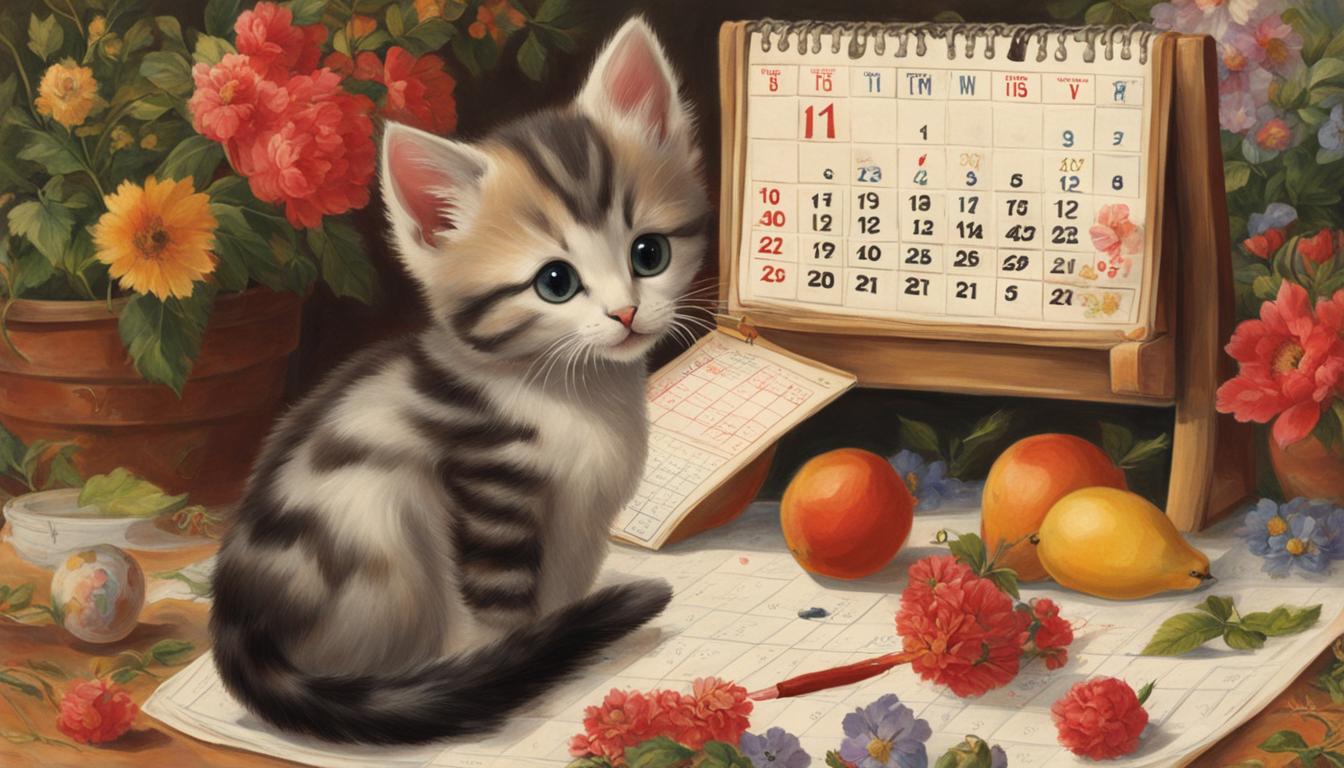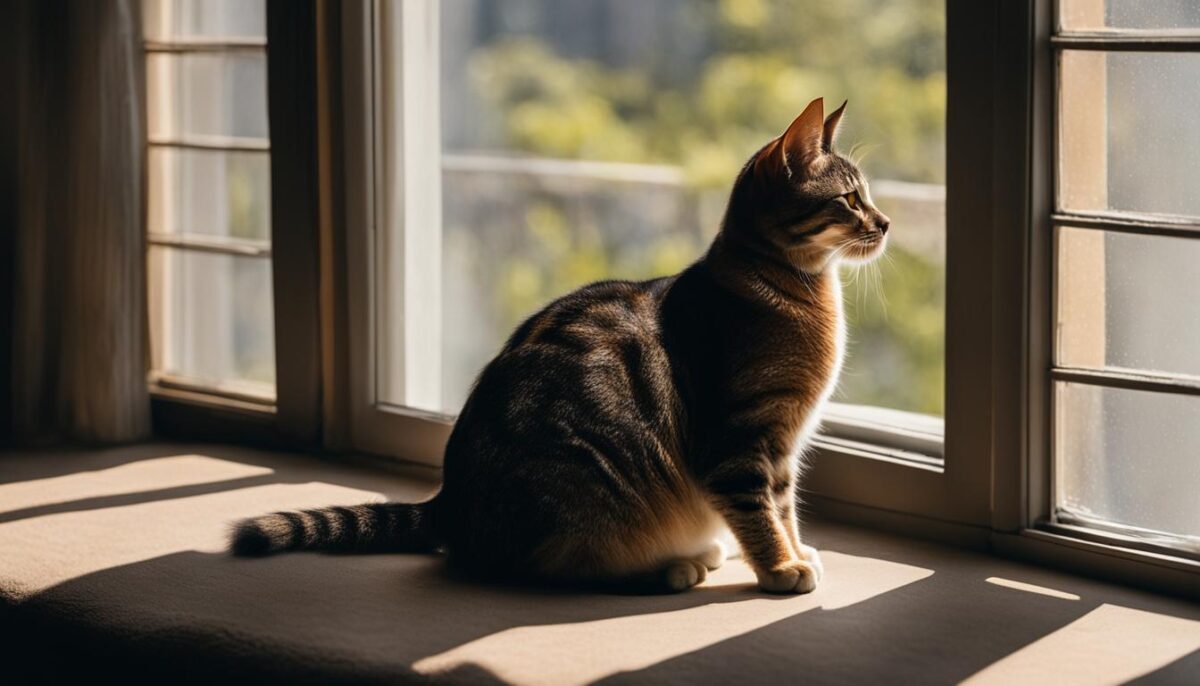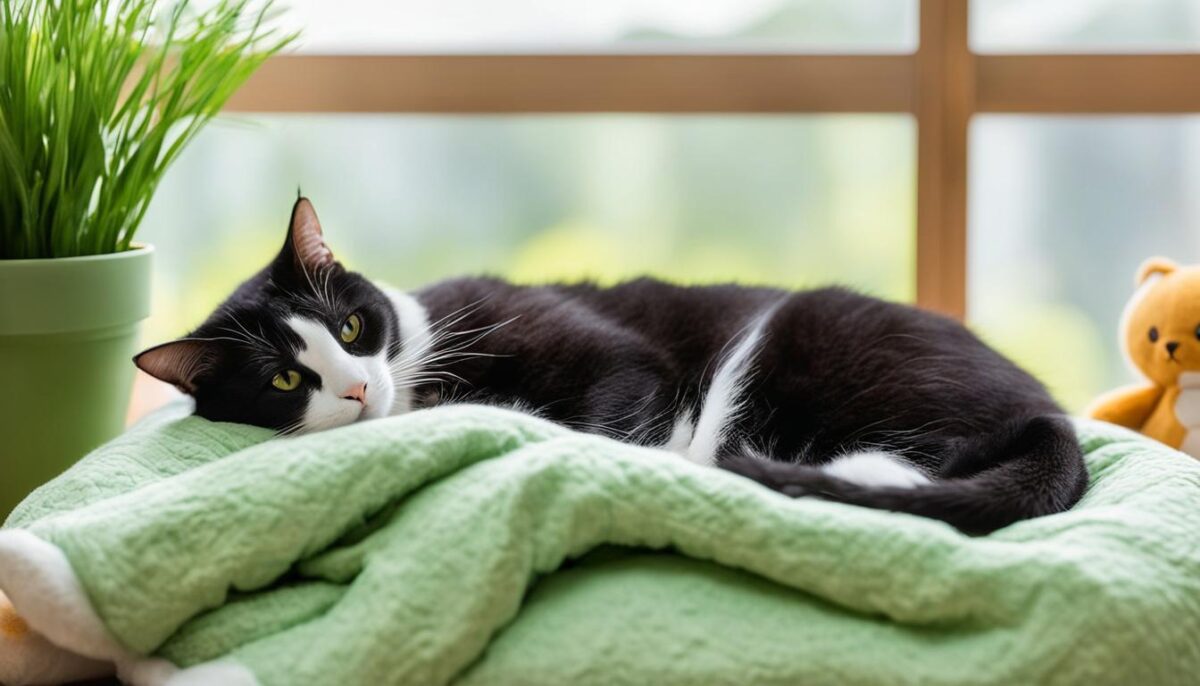You might wonder when your furry friend can become a mom. Cats can have babies at a young age. They are known for strong feline fertility. Female cats, which we call queens, can be moms when they are about 4 months old. Male cats, called toms, can make babies at this age too. Knowing this helps you take good care of your cat. You can prevent baby cats if you are not ready for them.
Key Takeaways
- Cats can become parents when young.
- Queens can have babies starting around 4 months old.
- It’s good to fix your cat early to prevent kittens you didn’t plan for.
- Both female and male cats are ready to breed at a young age.
- Learning about cat pregnancy age and breeding age in cats is smart for taking care of your pet.
Understanding the Feline Reproductive Cycle
Have you ever wondered how and when cats reach a point where they can have kittens of their own? Let’s dive into the journey of a cat’s reproductive cycle, which is full of interesting changes and behaviors.
The Onset of Sexual Maturity in Cats
Cats grow up fast! Most kittens start showing signs of sexual maturity in cats around 4 to 6 months old. That’s when they can start having kittens of their own. As pet owners, it’s important to keep an eye on these signs so we can make sure our furry friends stay healthy and happy.
Natural Breeding Behaviors in Cats
When cats are ready to find a mate, you might notice some changes. This is called the cat estrus cycle or heat cycle, and it’s when female cats let male cats know they are ready to have kittens. They may meow a lot, be extra cuddly, and might even try to sneak outside to find a mate!
Seasonal Influence on Cat Reproduction
Cats are more likely to have kittens during certain times of the year. This usually happens when the days are longer, and it’s warmer outside. It’s like nature’s way of making sure there’s enough food and sunshine for the kittens to grow strong.
| Season | Average Litters | Daylight Hours |
|---|---|---|
| Spring | High | Longer |
| Summer | High | Longest |
| Fall | Reduced | Shorter |
| Winter | Lowest | Shortest |
As we learn about how cats grow up and have kittens, we can be better friends to them. It’s all about caring and making smart choices for our furry critters!
What Age Can Cats Get Pregnant
Have you ever wondered how soon your little furry friend can become a mom? Well, cats can start having kittens as early as 4 to 6 months old. That’s why it’s important to know about their growth and how to keep them healthy.
Early Signs of Cat Maturity
When cats are growing up, you might notice some signs that show they are getting ready to be parents. These signs are part of what we call feline sexual maturity. For example, your cat may start meowing more or being extra cuddly. That means they’re looking for a mate!
- Lots of meowing or noise making
- Rubbing against things or people
- Trying to go outside more often
Why Early Spaying and Neutering Is Suggested
Since cats can have kittens so young, many vets say it’s a good idea to have them spayed or neutered when they are about 4 months old. This helps to stop them from having unexpected litters of kittens and helps keep the number of homeless pets down.
| Age | Spaying/Neutering | Benefits |
|---|---|---|
| 4-6 months | Recommended | Prevents early pregnancies |
| After 6 months | Still possible | Controls pet population |
Remember, taking care of your cat’s health also means thinking about their future. So, learning about the age of cat pregnancy, looking out for feline sexual maturity signs, and considering early spaying and neutering can help your pet have a happy and healthy life.
Typical Behaviors of a Cat in Heat
When your cat enters its heat cycle, certain cat in heat symptoms become very clear. Maybe you’ll hear more meowing or notice that your furry friend is a bit more loving than usual. Understanding these changes can help you know what to expect and when it might be time to talk to the vet about the next steps, like spaying or neutering.
Vocalization and Affectionate Gestures
Cats can be pretty chatty, but when they’re in heat, they turn it up a notch. You might hear long, drawn-out meows as they look for attention. But that’s not all – your cat may also stick close to you, rub against your legs, and even demand petting more often. These feline estrus behaviors are their way of signaling that they’re ready to find a mate.
Physical Indicators of Feline Estrus
Some signs aren’t just about what you hear or feel; they’re also about what you see. For instance, a cat in heat might raise its hindquarters in the air or roll around on the ground. This physical way of communicating its fertile status is quite common. You may even notice some physical changes, like its nipples becoming a brighter pink color. To help you recognizing heat in cats, here’s a handy table with the key behaviors to watch for:
| Behavior | Description |
|---|---|
| Increased Vocalization | Longer, more frequent meowing or yowling. |
| Affectionate Gestures | Rubbing against people or objects, seeking extra attention. |
| Physical Changes | Nipples may become more pronounced and pink, known as ‘pinking’. |
| Presenting Posture | Raising hindquarters and treading back legs while the front remains down. |
| Rolling on Ground | Rhythmic rolling or writhing on their backs. |
Remember, while these signs are totally normal for a cat in heat, keeping an eye out for them helps you better care for your pet’s health and wellbeing. And if you decide not to breed your cat, spaying or neutering can prevent these behaviors and help keep your kitty safe and comfortable.
Caring for Your Pregnant Cat: Essential Tips
When your cat is expecting kittens, there are some important things you need to do for her. Taking care of a pregnant cat means you are helping her and her babies to be healthy. Let’s learn how to take care of your cat during this special time!
Nurturing expectant queens is both rewarding and crucial. Early in her pregnancy, your cat’s belly will grow a bit and her nipples may look pink and bigger. She might want to eat more, too. Later, she will look for a safe spot where she can have her kittens. You can help by making her a cozy corner to rest and be comfortable.
Here’s a small list of what to do to make sure your furry friend gets the best feline pregnancy management:
- Feed her cat food that’s made just for pregnant cats because it has extra good stuff she needs right now.
- Give her a quiet place to sleep and feel safe.
- Visit the vet to check that everything is going okay.
- Keep her inside so she stays safe and doesn’t get into trouble.
Now, look at our table below. It shows what your cat needs when she is pregnant:
| Weeks of Pregnancy | What To Do |
|---|---|
| 1-3 Weeks | Give her good food and a lot of love. |
| 4-6 Weeks | Make her a bed in a quiet spot. |
| 7-9 Weeks | Prepare for the arrival of her kittens and keep her cozy. |
Remember, your cat counts on you to take care of her, especially when she’s about to become a mom. So, give her all the love and care she needs!
Keep these tips in mind and you’ll do a great job helping your cat through her pregnancy. She’s lucky to have someone as caring as you!
The Birthing Process: From Conception to Kittens
Watching a mama cat, or “queen,” have her babies is quite special. When the time comes, the mom will start to look for a safe spot. This is a sign she is ready to have her kittens. This part of having kittens is called cat labor. Then, comes the kitten delivery.
Stages of Cat Labor and Delivery
Before kittens arrive, the mom cat will show signs of nesting and she might act a bit uncomfortable. This is the beginning of labor. Soon, she starts the hard work of delivery. Each kitten will come out wrapped in a tiny sac. Mom knows just what to do. She cleans the sac off so her new baby can breathe and move.
Nurturing the Newborn: Mommy’s Role and Yours
Right after newborn kittens care starts. It is mostly up to the mom cat. She cleans them, feeds them, and keeps them warm. But you can help, too, by making sure they all have a cozy spot to snuggle in. You also have to make sure it’s quiet so mom and babies can rest.
Here is what happens during the whole birthing process. We call these the feline pregnancy stages:
| Stage | Signs | What to Do |
|---|---|---|
| Pre-Labor | Mom looks for a safe spot and might seem restless. | Give her a quiet place with a box or bed just for her. |
| First Stage of Labor | Mild discomfort, she might meow or pant. | Keep an eye on her, but it’s best to give her space. She knows what to do. |
| Delivery | The kittens are born, usually one every 30-60 minutes. | If mom is doing her job, just watch from a distance. If there are problems, you might need to call a vet. |
| After Birth | The mom cleans the kittens and they start to nurse. | Make sure mom and kittens are comfortable. Check on them softly, but try not to disturb them too much. |
Remember, mom cats take care of their babies very well. You just need to make sure they have a safe place and that they get to visit a vet to make sure everyone is healthy.
Conclusion
Being a cat owner means you have the big job of knowing when and how kitties can become parents. Cats can start having babies really young, so it’s smart to learn about feline pregnancy knowledge. This helps make sure you are taking care of your furry friend the best way and being a responsible cat owner. By keeping an eye out for the signs that show a cat is ready to have kittens, you can make sure they stay healthy and happy.
It’s also good to remember to prevent unwanted litters, and that’s where helping your cat not have babies by visiting a vet comes into play. This keeps the number of homeless cats down and means fewer little ones without a family. Plus, it’s better for your cat’s health too!
So, remember the important stuff you’ve learned here. You now know more about when cats can get little ones and how to care for them if they do. But, the best choice for many pet owners is to make sure their cats don’t have babies if they are not ready. Take care of your cat, and you’ll both be happier for it!
FAQ
At what age can cats start getting pregnant?
Cats, known for their **feline fertility**, can become pregnant as early as 4 to 6 months of age. This is approximately when they reach sexual maturity, so it’s important to be aware of the **breeding age in cats** to manage their reproductive health responsibly.
What are the signs that a cat is reaching sexual maturity?
**Sexual maturity in cats** can be identified by signs such as increased vocalization, affectionate behavior, and, for female cats, going into heat or oestrus, which is a part of the **cat estrus cycle**. These are all indicators that your cat is ready to breed.
How does the season affect cat reproduction?
There’s a notable **seasonal influence on cat reproduction**, with warmer months and longer daylight hours typically seeing an increase in breeding activities. This seasonality ensures that kittens are born during times when conditions are better for their survival.
Why is early spaying and neutering recommended for cats?
Vets often recommend **early spaying and neutering** to prevent unplanned litters and to help control the pet population. It is a common preventive measure taken around the age of 4 months, before cats reach the **age of cat pregnancy**.
How can you tell if a cat is in heat?
A cat in heat may exhibit **cat in heat symptoms** such as loud vocalizations, seeking more affection, and exhibiting certain behaviors like rolling on the ground. These are part of the **feline estrus behaviors**, indicating the cat is fertile and seeking a mate.
What care should be given to a pregnant cat?
**Pregnant cat care** includes a nurturing diet, providing a safe and warm nesting area, and monitoring for physical and behavioral changes. Early signs include pinker nipples, slight weight gain, and ultimately an increase in appetite as the **feline pregnancy** progresses.
What are the stages of cat labor and delivery?
The **stages of cat labor** begin with nesting and mild distress, followed by the birth of each kitten, which the mother cleans and stimulates to breathe. During this time, providing a comfortable environment and support is crucial for the **kitten delivery** process.
How can I support a mother cat and her newborn kittens?
While the mother cat plays the primary role in **nurturing the newborn**, your role is to ensure that they have a safe, warm, and quiet environment. It’s important to be familiar with **newborn kittens care** to assist the mother cat if necessary.


